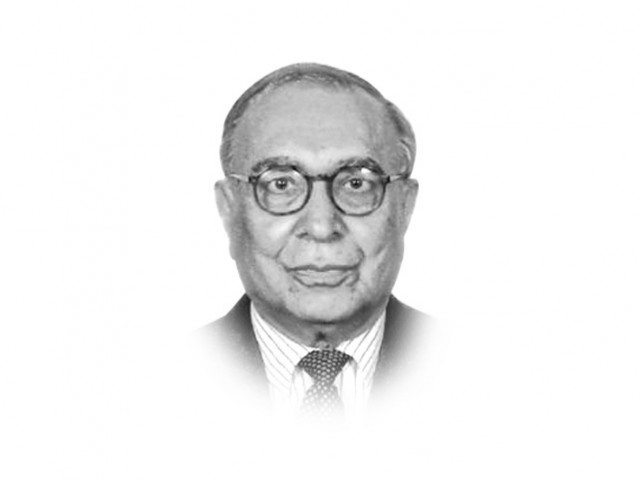Sectarian schism and state policy
First step in war against extremism and violence is for the Republic of Pakistan to overcome its own ambivalence.

Sectarian schism and state policy
Far too often, attempts are made to diffuse the impact of planned sectarian murders by arguing that the underlying schisms have a long history that, in the case of the Shia-Sunni divide, is as old as the religion of Islam. This deterministic view is propagated to obfuscate the context of present troubles and, thereby, questions of responsibility and culpability. It suits governments that wish to evade the fact that protection of life and property of the citizens regardless of their faith, creed or culture is the primary responsibility of the state. It is also convenient for those religious leaders that have kindled fires in pursuit of political power. Perplexed by the complexity of state organisation and the modern world, sections of the so-called ulema have frequently reduced politics to equations of hatred.
Six factors stand out when one seeks to define the context of present-day sectarian violence in Pakistan. One, several political parties — not just the religious ones — turned their back on the tradition of democracy on which the founding fathers wanted to base Pakistan’s polity. Realising that they would not be able to capture power in Pakistan by the electoral process, they nurtured constituencies of followers fired by parochial passions of ethnicity and sectarianism. Two, there has been an instrumental use of religion to gain legitimacy for illegal seizures of power and for the liberation of Afghanistan from the Soviet Union and Kashmir from India for decades; it reached a high point with General Ziaul Haq. Three, the Afghanistan model spawned the organisation of armed militias wedded to the use of force to attain political ends in domestic politics as well. Four, the same model also provided a tested route to financial support from within the country and from foreign sources. Fifth, the foreign funding shrunk the religious reference to narrower and narrower ‘ideologies’; the fragmentation of the Sunni reference into a number of sub-sects employing varying degrees of radicalism and violence is a case in point. Tragically for Pakistan, patronage was available from internal and external sources in each and every case. This process weakened the democratic forces as well as bonafide religious parties engaged like their counterparts elsewhere in the Islamic world in synthesising Islamic precepts and values with the demands of the contemporary world. Sixth, the special focus on educational institutions by the darker religious movements made huge dents in the liberal academic tradition that Pakistan began with. It is not just a matter of religious madrassas that are demonised by the liberal elite indiscriminately. The animus has spread to the so called ‘secular’ academia as well.
As a responsible state, Pakistan should have remained loyal to the ideal of a Muslim civil state that had gathered people of all persuasions under its flag. They had transcended all past and present schisms to embrace a distinct nationhood. The essence of Pakistan lay in it being inclusive. A close study of the rise of militant organisations, including the unabashedly sectarian ones such as the Sipah-e-Sahaba and the Jaish-e-Mohammed, demonstrates that they were able to gain strength largely because successive governments leveraged that strength into their own political designs. When they became a Frankenstein they were banned, though not much was done to prevent their protean existence. Nor did the state ever implement an effective policy to cut off external financing for the new incarnations of the same brand of radicalism. In time, the main instruments by which it could have curbed extremist organisations became dysfunctional as seen in frequent failures to carry out prosecutions to a point where the courts could hand down unambiguous judgments.
In fact, it is a bizarre facet of Pakistan’s history that foreign actors — be they terrorists invoking some perverted version of Islamism or Western intelligence establishments creating rival lobbies — are able to act with impunity and without any significant resistance from the state of Pakistan. This is an important factor in the growing polarisation in society.
It is naive to argue that law-enforcement agencies can eliminate the scourge of sectarianism by themselves. This kind of violence stems from years of evil indoctrination and is sustained by intricate organisation. The battle for the hearts and souls of our people will have to be won in several theatres. But success will not come until the state radically alters its view of the very existence of groups that are using force to recreate Pakistan, not so much in the image of Islam, but that of criminalised cults built around highly bigoted figures. Only the other day, the new president of France made the following observation during a ceremony connected to the sufferings of the Jewish people in France during the Nazi occupation: “All ideologies of exclusion, all forms of intolerance, all fanaticism, all xenophobia that seek to develop the mentality of hatred will find their way blocked by the Republic.” So, the state has to do much more than chase sectarian killers with poorly equipped and easily out-gunned police. It has to upgrade the apparatus of the state manifold but no less importantly, it has to make a solemn pledge to the people that it will, as Francois Hollande put it, block all channels that spread the poison that is now destroying our society. The first step in the war against extremism and violence is for the Republic of Pakistan to overcome its own ambivalence.
Published in The Express Tribune, August 25th, 2012.














COMMENTS
Comments are moderated and generally will be posted if they are on-topic and not abusive.
For more information, please see our Comments FAQ